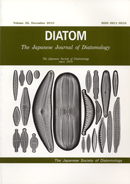Volume 26
Displaying 1-22 of 22 articles from this issue
- |<
- <
- 1
- >
- >|
Article
-
2012Volume 26 Pages 1-9
Published: December 31, 2012
Released on J-STAGE: September 20, 2013
Download PDF (3010K) -
2012Volume 26 Pages 10-16
Published: December 31, 2012
Released on J-STAGE: September 20, 2013
Download PDF (1093K) -
2012Volume 26 Pages 17-39
Published: December 31, 2012
Released on J-STAGE: September 20, 2013
Download PDF (1572K) -
2012Volume 26 Pages 40-43
Published: December 31, 2012
Released on J-STAGE: September 20, 2013
Download PDF (671K) -
2012Volume 26 Pages 44-45
Published: December 31, 2012
Released on J-STAGE: September 20, 2013
Download PDF (1579K)
Special issue: Diatoms and education
-
2012Volume 26 Pages 46
Published: December 31, 2012
Released on J-STAGE: September 20, 2013
Download PDF (561K) -
2012Volume 26 Pages 47-50
Published: December 31, 2012
Released on J-STAGE: September 20, 2013
Download PDF (702K) -
2012Volume 26 Pages 51
Published: December 31, 2012
Released on J-STAGE: September 20, 2013
Download PDF (946K) -
2012Volume 26 Pages 52
Published: December 31, 2012
Released on J-STAGE: September 20, 2013
Download PDF (1093K) -
2012Volume 26 Pages 53
Published: December 31, 2012
Released on J-STAGE: September 20, 2013
Download PDF (947K) -
2012Volume 26 Pages 54
Published: December 31, 2012
Released on J-STAGE: September 20, 2013
Download PDF (886K) -
2012Volume 26 Pages 55
Published: December 31, 2012
Released on J-STAGE: September 20, 2013
Download PDF (1076K) -
2012Volume 26 Pages 56
Published: December 31, 2012
Released on J-STAGE: September 20, 2013
Download PDF (828K) -
2012Volume 26 Pages 57
Published: December 31, 2012
Released on J-STAGE: September 20, 2013
Download PDF (891K) -
2012Volume 26 Pages 58
Published: December 31, 2012
Released on J-STAGE: September 20, 2013
Download PDF (920K) -
2012Volume 26 Pages 59
Published: December 31, 2012
Released on J-STAGE: September 20, 2013
Download PDF (781K) -
2012Volume 26 Pages 60
Published: December 31, 2012
Released on J-STAGE: September 20, 2013
Download PDF (913K) -
2012Volume 26 Pages 61
Published: December 31, 2012
Released on J-STAGE: September 20, 2013
Download PDF (1023K) -
2012Volume 26 Pages 63
Published: December 31, 2012
Released on J-STAGE: September 20, 2013
Download PDF (927K)
-
2012Volume 26 Pages 64
Published: December 31, 2012
Released on J-STAGE: September 20, 2013
Download PDF (522K) -
2012Volume 26 Pages 65-66
Published: December 31, 2012
Released on J-STAGE: September 20, 2013
Download PDF (1146K) -
2012Volume 26 Pages 67
Published: December 31, 2012
Released on J-STAGE: September 20, 2013
Download PDF (722K)
- |<
- <
- 1
- >
- >|
